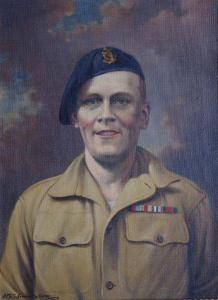
|

|
| Trooper Michael Stuart STRONG | |
|
A Squadron North Irish Horse, Royal Armoured Corps Date of birth: 30th July 1923 Date of death: 23rd May 1944 Killed in action aged 20 Buried at Cassino War Cemetery Plot III Row G Grave 9 |

|
| Michael Stuart Strong was born at Bedford on the 30th of July 1923 the third and youngest son of the Reverend Thomas Hammond Strong, Rector of Sandy, and Florence Frances (nee Chapman) Strong, of The Rectory, Sandy in Bedfordshire. He was educated at Lancing College where he was in Sandersons House from September 1937 to 1939. On the morning of the 22nd of May 1944 the officers and senior NCOs of the North Irish Horse were briefed by Major GP Russell for an attack the following morning, in concert with Canadian Brigades, on the German positions known as the "Hitler Line”. The North Irish Horse was to be in support of the Canadian 2nd Brigade on the right of the attack. The attack was to be part of a wider attempt by the Allies to break out of the Anzio beachhead and trap the bulk of the German 10th Army under General von Vietinghoff. At 5.45 am on the morning of the 23rd of May 1944 the Canadian artillery commenced firing a barrage on the German positions opposite, with the order for the infantry and tanks to advance coming at 6 am. The distance to the objective was just short of one thousand yards, the first part of which was through a forest of small but densely packed trees. This led to the commanders of the tanks having to drive with their heads exposed from their turrets, leaving them vulnerable to snipers who had strapped themselves to the trees. Despite German artillery and mortars firing a continuous barrage most of the tanks reached the northern edge of the wood without damage. The Canadian infantry which were following the tanks was not so lucky and casualties among their ranks were heavy. At 7.30 am, with enemy fire slackening, the North Irish Horse re-grouped and at 8am, under cover from the smoke and dust thrown up by German shells, the order to continue the advance was received. Although the remaining distance to the objective was now 400 yards, it was all across open ground and communication between the tanks and the infantry was severely hampered by the high number of casualties among the Canadian signallers. On emerging from the tree line A Squadron were held up by a mine field and were also engaged by a number of anti tank guns, losing two of their tanks on the mines and four to anti tank fire. They in turn managed to destroy a Panther Mark V, two Panther Mark IVs and two 75mm anti tank guns. Lieutenant D.F. Hunt was charged with finding a way around the mine field but his Churchill tank fell into a wadi. Meanwhile B and C Squadrons had advanced to the Pontecorvo-Acquino Road but were met with intense fire from enemy tanks and self propelled guns, losing eleven tanks in the process. At around 10.45 am A Squadron began to organise a defensive position and a composite force of tanks took the second objective at midday but were forced to withdraw at 12.45pm due to heavy artillery and mortar fire, losing a further seven tanks in a tank trap, which left only four tanks remaining to fall back and join A Squadron. An anticipated German counter attack never materialised and at 4.50pm the Germans were seen evacuating their positions The North Irish Horse had lost twenty five tanks in the engagement taking casualties of four officers killed with nine wounded and twenty nine other ranks killed with thirty three wounded. |
|
| Sandersons House |
Back